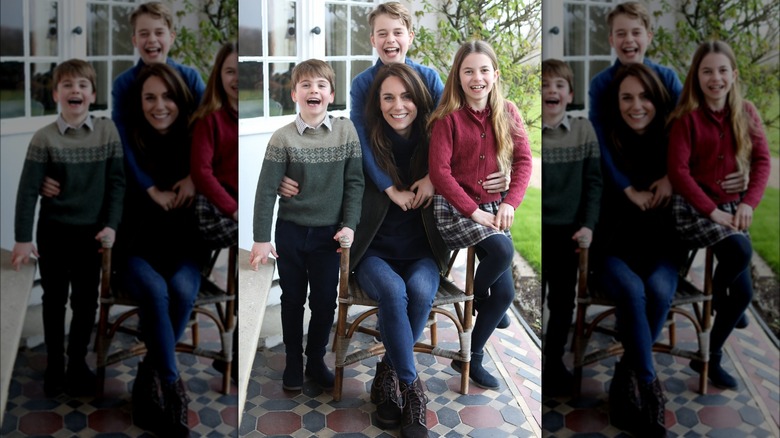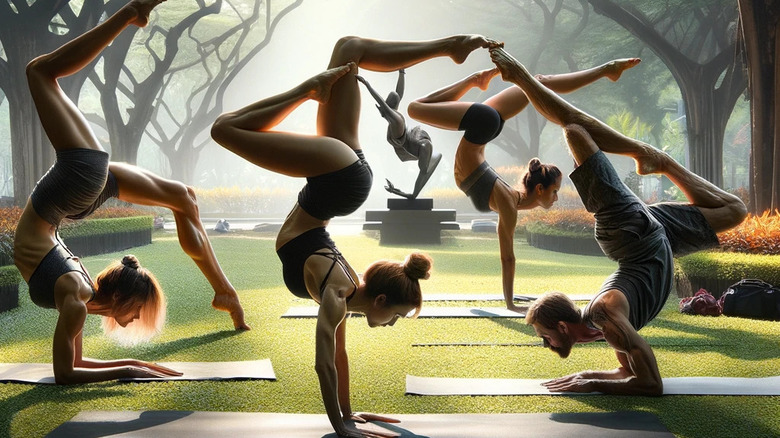An AI Expert Breaks Down Kate Middleton's Doctored Family Photo
Earlier this week, Kate Middleton, also known as Catherine, Princess of Wales, posted a photo of herself in a pleasant group with her three children on her official X, formerly known as Twitter profile. Originally, this photo was claimed to have been taken by Middleton's husband, Prince William, but on Monday, Middleton admitted in a follow-up tweet that the photo had been doctored to some extent. The precise methods with which the photo was doctored and the extent to which it was doctored have not been elaborated upon beyond Middleton saying she "occasionally experiments with editing." That said, one of the primary theories is that it was either created or doctored through the use of AI imaging, with theorists from across the internet carefully dissecting the image's metadata and utilizing AI-detection tools like AI or Not in search of conclusive proof.
Dev Nag, AI expert and CEO and founder of the AI chatbot system QueryPal, offered some insight into this image's mysterious intricacies and the overall mechanics behind AI image generation.
"AI generates images in the same way it sees images, which is in ways that are a little different from how we see the world," Nag explained in a message to SlashGear. "Without special care taken by experienced users of AI imagery, you often see hypersmooth surfaces, unusual color consistency, a lack of intricate patterns, lighting/shadow discrepancies, and even more obvious signs (strange numbers/positions of fingers; misspellings on text generated within the photo; and so forth)."
The Middleton mystery
As Nag explained, it is gradually becoming more difficult to discern between images generated by AI and those directly doctored through the use of programs like Photoshop. This is due in large part to the fact that modern Photoshop versions have AI touch-up features like Generative Fill integrated. There are signs that these integrated tools were used in the Middleton image.
"One inconclusive but suggestive sign that it was AI is Princess Charlotte's left sleeve, which shows a strange background texture (of her skirt, apparently) floating ahead of the top of her sleeve. This is consistent with the use of Photoshop's Generative AI tool, which is still improving and can result in artifacts like this."
However, Nag also notes that the evidence in the image seems more indicative of image compositing than full AI generation, explaining that the aforementioned sign could be caused by "compositing multiple layers together and leaving the wrong section visible."
"One unusual aspect of the image which does NOT look like AI is Prince Louis' right fingers; AI doesn't tend to create novel but biomechanically possible poses (as this is), instead making far more obvious mistakes that are outright implausible."
Nag posits that the image may have been doctored through compositing in an effort to get consistent photogenic faces on all of Middleton's children, a classic difficulty for parents taking photos.
How convincing are AI fakes?
While on the subject of generating falsified images with AI, we asked Nag how effective AI actually is in this task versus an exceptionally skilled Photoshop user.
"AI could create more effective fakes than traditional Photoshop techniques, and in far less time, but requires a deep knowledge of where it (currently) shines and where it fails. AI excels at replicating natural textures, and mimicking particular styles from history and culture, and at small patches of infill in ways that carry on a surrounding context. It currently does very poorly when it comes to illustrating the world in rare configurations – because it's not really modeling the world deeply (yet), but superficially reusing and combining features seen within the training data."
To illustrate his point, Nag showed us an image created with Dall-E running the latest version of ChatGPT4 of several individuals in unusual yoga poses, resulting in some bizarre and anatomically impossible stretching.
All that said, AI technology is accelerating at a remarkable pace, and it's only a matter of time before its falsification techniques exceed those of a Photoshop user. "For the time being, an experienced Photoshop practitioner has the edge on creating convincing fakes, but the gap is narrowing every month. Generative AI is getting better at understanding the deeper patterns in the training data, and some of the most obvious problems from just 12 months (e.g., almost always getting finger counts wrong) have gotten better. Stay tuned."
Compositing versus AI
So, by Nag's estimation, the Middleton photo is likely a result of photo compositing, meshing several photos of Middleton's children together to create a nearly picture-perfect family shot, possibly with some AI touching-up employed afterward.
As for the precise reason this photo was doctored, that's still a secret kept by the Royal Family. The primary reason so many internet-goers have been concerned is that Middleton has not been seen in public since undergoing abdominal surgery in January, which has led to speculation that she is in poor health. In all likelihood, Middleton is probably fine, and this photo was only composited because she couldn't get her kids to sit still for a family portrait.
"One possible motivation behind the image manipulation is one that any parent of multiple kids will be familiar with – it was impossible to get all the children to make the right expression in the same shot, so there was an attempt to stitch similar images together, and we're seeing the seams," Nag said.



